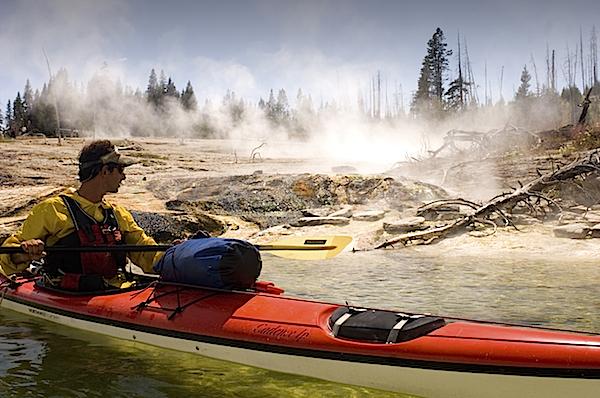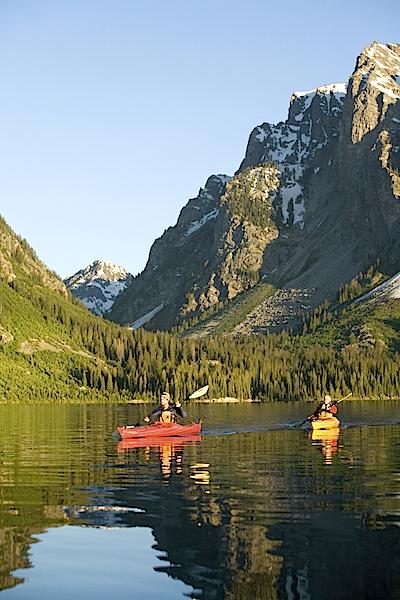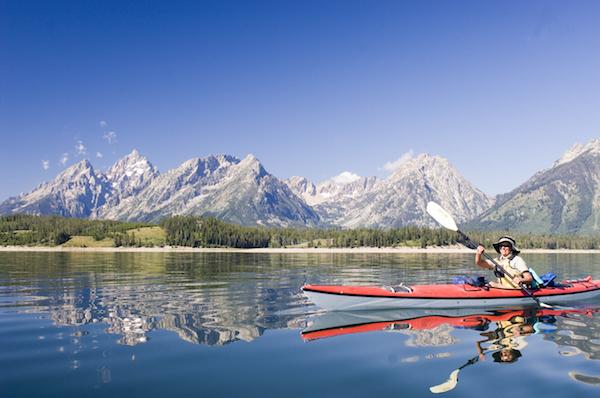
A sea kayak trip at Yellowstone allows you to take a different approach to viewing the West Thumb Geyser Basin/O.A.R.S.
Editor's note: This is a special advertiser-supported article from the 2nd Annual Essential Guide to Paddling the Parks.
Had we been ashore, our feet might have been badly scalded, or worse, if we had absent-mindedly stumbled into a hot spring. But here, in a sea kayak just off the West Thumb Geyser Basin in Yellowstone National Park, the bubbling waters popped to the surface of Yellowstone Lake, merely a harmless marvel to watch. The park visitors on shore watched us, envious no doubt of our ability to meander along the edge of the geyser basin while slowly being rocked to the rhythm of the big lake.
Along with the bubble trails surfacing from unseen lakebed vents deep below, we passed cascades of steaming waters pouring directly into the lake from overflowing Lakeside Spring. We paddled by Fishing Cone, once a vigorous geyser that 19th century mountain men boastfully said they used to poach freshly caught trout. These days it's a comparatively meek, simmering hot spring. As we paddle towards shore for a closer look at Yellowstone National Park's geothermal plumbing, the puckering sounds of mud pots and their pungent, sulfurous odor carry on the air.
Far and away, most Yellowstone visitors miss such a watery perspective of a geyser basin. Not only does a sea kayak provide a unique view of the West Thumb basin (as well as the bubbles percolating to the surface), but it comes without the crowds encountered on boardwalks. There's time enough for that on a Yellowstone vacation. Setting off in a sea kayak, well, that's a bonus.
Small groups of kayakers enjoy this view of West Thumb three times a day in summer, with O.A.R.S. guides leading the way. Safe boating practices are explained first, and then kayaking instruction, at the Grant Village boat launch. After that, you shove your two-person kayak off into Yellowstone Lake. For three hours you paddle about West Thumb, taking in the unique views of the geyser basin, searching the lodgepole forests that rim the shores for wildlife.
Early risers can sign up for a 6:30 a.m. departure. The soft morning light glints from the lake surface and the fumarole's steam clouds rising from the geyser basin. And then there's the wildlife. Squadrons of white pelicans fly by. Bald eagles perch patiently high in the trees, waiting for one of the lake's famed Yellowstone cutthroat trout to rise too near to the surface. Bison graze the grassy meadows in the lodgepole pine forest.
Travelers to northwestern Wyoming should also make time to visit Yellowstone's southern neighbor, Grand Teton National Park. Though world-famous for its mountain crags, Grand Teton has its own watery adventures. There are smaller lakes, such as Jenny, String, and Leigh, or you can set out with O.A.R.S. on a two-night tour of Jackson Lake, always with the Tetons in sight.
Beneath towering Mount Moran, your base camp is secluded on Grassy Island in Moran Bay, on the far side of the lake. Grassy Island brings you a more restful, even contemplative, exploration of Grand Teton. There's a lot to see. Make the short trip across the small bay and hike up Moran Canyon, explore the western shoreline by kayak, fish for a trout dinner, or head out after dark for a moonlight paddle. Take your sketchpad and, like Thomas Moran, try to capture the mountain that bears his name. The late-19th century painter brought his colorful visions of Yellowstone and the Tetons back to the halls of Congress; you can take yours home to rekindle memories of your adventure year after year.
Or, you can simply kick back and soak in the scenery.
The paddling, the campfires, and falling asleep under the stars to the rippling lake waters all combine for the perfect outing to get youngsters (minimum age is 4) and teens hooked on the outdoors, not another video game or Facebook post.
Extend your vacation with a third day in Grand Teton by floating down the legendary Snake River with O.A.R.S. Drifting downstream from the put-in near Pacific Creek in river rafts, you might spot an osprey perched overhead, or pulling a fat trout from the Snake. River otters frolic along this stretch of the river, while moose, pronghorn antelope, and bison roam the river banks.
Lunch in a cottonwood or aspen grove, with the Tetons a majestic backdrop. With the centennial of the National Park Service in 2016, more people are looking to the national parks for a vacation. With O.A.R.S., you will go beyond the crowds





Comments
Looks like a great trip!